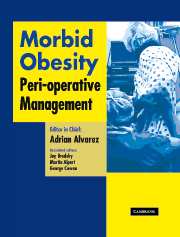Book contents
- Frontmatter
- Contents
- Contributors
- Foreword
- Preface
- Acknowledgments
- Dedication
- Section 1 General aspects
- Section 2 Pathophysiology
- Section 3 Pre-operative management
- Section 4 Peri-operative management of co-morbidities
- Section 5 Pharmacology
- Section 6 Monitoring
- Section 7 Intra-operative management
- 20 Positioning the morbidly obese patient for surgery
- 21 Airway management
- 22 Inhalational anesthesia
- 23 Total intravenous anesthesia
- 24 Anesthetic management for the obese parturient
- Section 8 Post-operative care
- Section 9 Conclusions
- Afterword
- Index
22 - Inhalational anesthesia
from Section 7 - Intra-operative management
Published online by Cambridge University Press: 17 August 2009
- Frontmatter
- Contents
- Contributors
- Foreword
- Preface
- Acknowledgments
- Dedication
- Section 1 General aspects
- Section 2 Pathophysiology
- Section 3 Pre-operative management
- Section 4 Peri-operative management of co-morbidities
- Section 5 Pharmacology
- Section 6 Monitoring
- Section 7 Intra-operative management
- 20 Positioning the morbidly obese patient for surgery
- 21 Airway management
- 22 Inhalational anesthesia
- 23 Total intravenous anesthesia
- 24 Anesthetic management for the obese parturient
- Section 8 Post-operative care
- Section 9 Conclusions
- Afterword
- Index
Summary
Introduction
Any discussion of inhalational general anesthesia for obesity surgery necessarily requires a rudimentary discussion of the pharmacodynamics and pharmacokinetics of inhalational anesthetic agents (see also Chapter 15). This discussion will be of a general nature describing some of the physical principles of the uptake and distribution of general anesthetics, and additionally will be taken into account some of the specifics as they relate to the inhalational agents in current common clinical use. Additionally, the particular effect that the obese physical condition has upon uptake and distribution of these agents will be analyzed. Finally, the specific inhaled agents and their various effects in the obese patient will be explained.
Definitions of pharmacokinetics and pharmacodynamics
Pharmacokinetics means the effect the body has on a drug with respect to distribution and metabolism. This for an intravenously (i.v.) administered drug generally implies the extent to which it is soluble in the blood and tissues, the extent to which it distributes itself in the body, and the way in which the drug is metabolized (for example, in the liver or bloodstream) or excreted by the kidney. These affect the distribution half-life and elimination half-life of the drug. For inhalational agents there are physical properties that are specific to each inhalational agent, for example their vapor pressure, solubility in tissue and blood, and potency with respect to the effective alveolar concentration. Alveolar concentration will, in turn, determine blood concentration and tissue concentration.
- Type
- Chapter
- Information
- Morbid ObesityPeri-Operative Management, pp. 297 - 304Publisher: Cambridge University PressPrint publication year: 2004

